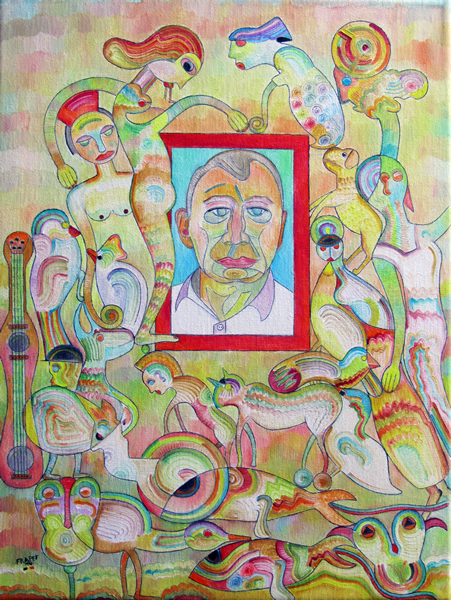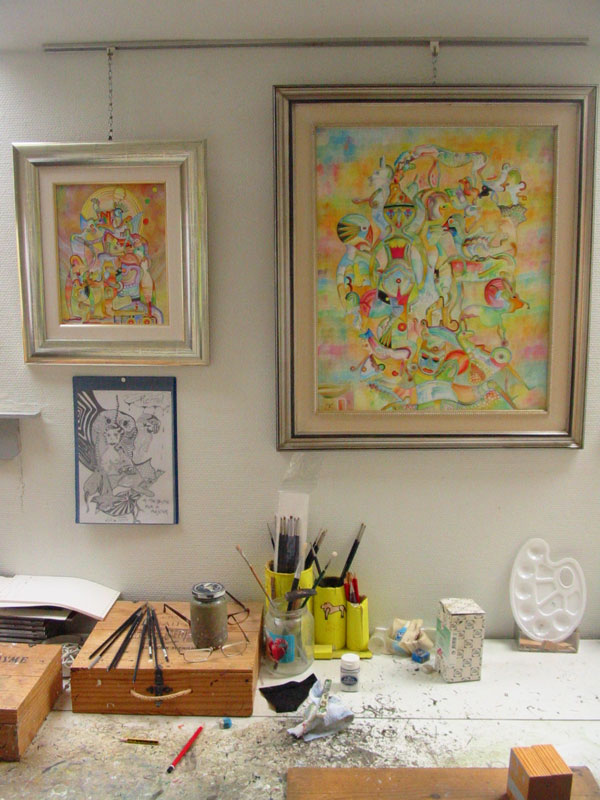Frans Peerlings
Bonheiden, 08/01/1939.
Autodidact zelfstandig kunstenaar / Autodidact independent artist.
Pseudoniem / Pseudonym : Frapee.
Ontdekt door/ discovered by Staf Gillé, conservator "De Witte vlag" Bonheiden.
Gesteund en gepromoot door schilder / Supported and promoted by painter Geo Sempels, abstract grootmeester / abstract grandmaster.
Gekend als Schilder van het Onbewuste / Known as painter of the Unconscious.
Eerste tentoonstelling / First exposition: 1986.
Schilderijen in particulier en openbaar bezit in binnen- en buitenland.
(Frankrijk, Italië, Nederland, Schotland,Portugal, Zuid Korea)
Paintings in private and public property at home and abroad.
(France,Italy, The Netherlands, Scotland, Portugal, South Korea)
Frans Peerlings
Kattendijkdok Oostkaai 62 bus 1.16
2000 Antwerpen-Antwerp België-Belgium
 Zelfportret/ Selfportret
Zelfportret/ Selfportret
 Altijd welkom in mijn atelier/ Always welkom in the studio
Altijd welkom in mijn atelier/ Always welkom in the studio
Raoul Maria de Puydt
Toen ik het bevriend bedrijf Univeg in Katelijne-Waver begin de negentiger jaren binnenliep, werd ik getroffen door het picturale coloriet dat dit neutrale industriegebouw van de veiling opfleurde. Veerle Deprez vertelde me over een zekere Peerlings. Ik reageerde zakelijk, maar hij bleef op mijn netvlies hangen en bij herhaling bracht onze vriend Frans Wauters hem in herinnering. Bij zijn verkiezing tot bestuurder van de vzw Vrienden van Felix de Boeck, toen zijn gezondheid reeds aan het wankelen was, overhandigde hij me fier zijn monografie over Frans, schilder van het onbewuste in zijn koninkrijk. Deze uitgave van 2002 vormt de perfecte inleiding tot het oeuvre van deze individualistische kunstenaar, die een eigen droomwereld opbouwde. Vandaag is hij er zeventig en kijkt na een schildersloopbaan van meer dan twintig jaar nog verder vooruit. Nog steeds borrelen de ideeën op vanuit zijn onderbewustzijn om zijn verhalen goed harmonisch in verfkleuren om te zetten.
Vele regionale kunstcritici hebben met vurigheid de analyse van deze figuur gemaakt. Hun wedervaren wordt in deze uitgave opgenomen. Zo greep Guido van den Bogaert terug naar het Book of Kells om Peerlings engelengeduld te beschrijven “om zorgvuldige vormen en kleuren in elkaar te verwerken als een monnik , die uit zijn fantasie een nieuwe wereld creëert in de marge van een handschrift.” Fons de Blezer stelt dan ook dat “deze universele zoeker naar de magische kringloop van het leven in zijn visuele voorstelling de nodige spankracht hiertoe geeft via de lineair verbinding.” Wat Rob Goswin op zijn beurt samenvat: “Hij vertelt vergeten gebeurtenissen uit zijn leven, hij creëert vreemde, maar authentieke verhalen. Vanuit de cirkels en andere gebogen lijnen ontwart hij langzaam maar zeker de sluier, die als een vage mantel over zijn onderbewuste drijfveren hangt. Intuïtief brengt hij onafwendbare emoties tot leven. Vanuit zijn schildershand vertrekken impulsen naar het doek. Wanneer de schemer uiteindelijk is opgetrokken komen vreemdsoortige creaturen, bizarre dieren, nog genetisch te ontwikkelen planten tot leven.” Hij besluit: “Hij slaagt erin door al deze associaties op het doek het gordijn te openen, waarachter de wonderlijke wereld van vergeten dingen schuilt.”
...
Paul Berckx van zijn kant, die verwijst naar de vriendschap met Geo Sempels (1926-1990), benadrukt de vormentaal van Peerlings in deze lyrische bewoordingen: “In tegenstelling tot Geo Sempels, die vanuit een indruk, een idee, zijn structuren en zijn kleurencomposities opbouwt, vertrekt Frans Peerlings zonder thema, zonder motief, maar enkel van zijn ondefinieerbaar onderbewustzijn. De aanloop is steeds een paar perfect getekende cirkels die geleidelijk , vanuit het onderbewuste, uitgebouwd worden met sierlijke kronkelende lijnen, ovalen, driehoeken of eenvoudige rechte lijnen. Uit dit deel van de lijnspelletjes groeit de uitbeelding van figuren, dieren, planten, bloemen, voorwerpen, vrouwen- en mannenhoofden of beelden die sierlijk in en door elkaar vloeiend, tot een geheel ontluiken waarbij penseellijnen en kleurenstippen en kleurenvlekken in zachte pasteltinten, uitgroeien tot een boeiend, aangrijpend, fascinerend geheel van figuren, afbeeldingen en vormen. Zijn werk blijft steeds voor hem een verrassing: een droom die realiteit wordt. Hij vertrekt dus niet zoals Geo Sempels vanuit een gecomposeerde achtergrond, die het hoofd- en de moederkleur is van het thema dat wordt uitgebeeld vanuit de opgevangen emoties of indrukken uit een bepaald feit of gebeuren. Frans Peerlings daarentegen vertrekt zomaar, het onbewuste leidt hem dan verder, met de kleuren tot nieuwe vormen en beelden.” Zoals mijn goede collega Gilbert Putteman bij een inleiding zei: “Zijn combinaties en versmeltingen, alwaar het mystieke, het ludieke, de hoop en de wanhoop hand in hand gaan en elkaar niet verlaten.”
Jean-Pierre de Bruyn merkt hierbij op: “De toeschouwer wordt uitgenodigd om op ontdekkingstocht te gaan tussen de symbolen, die hem worden opgediend. Hij ontdekt ‘aangezichten’, Ensoriaans van uitzicht, eveneens ‘Vrouwenfiguren’, die refereren aan elegante zusters uit de oudheid, de renaissance en de belle époque, maar evengoed aan het type van de ‘aardmoeders’ kunnen herinneren, of nog aan ‘gestileerde vogels’, die niet zouden misstaan in een Keltische of Etruskische tombe, ‘fabeldieren’. Decoratieve kwaliteiten, die mits een inspanning van de toeschouwer er een aantrekkelijk en boeiend kijkstuk van maken.”
Frans Peerlings slaat in de laatste jaren ook de vleugels uit buiten onze grenzen. Na een omvangrijke tentoonstelling in het NAVO-hoofdkwartier te Evere was hij te zien in het maison de la Culture te Monteauban (Fr) en in de Sint-Baafskerk Aardenburg (Nl), waar Anita Tournois schrijft “een waaier van extreem heldere kleuren in een waar regenboogeffect, kenmerkt zijn oeuvre.” Het meest opmerkelijk is de Koreaanse reactie van de President of the Society of Korea Illusart “I believe that the reason for the attraction of your work is that it evokes a certain Asian feeling, or at least that is how I and my colleagues feel. So there may very well be further exhibition opportunities for you in Korea.” Zo vaart de boot verder.
Peerlings’ kunststijl fascineert, lijkt ongrijpbaar. Bij de overvloeiing van beelden en vormen, speels door elkaar heen, is men nauwelijks uitgekeken. In de westerse figuratieve schilderkunst vond ik maar één gelijkenis, een onbetiteld schilderij van 160 x 90 cm, die hem wellicht totaal onbekend is, uit de gouden jaren van “La Jeune peinture belge”, 1947, en dat een collectieve realisatie was van o.m. Bertrand, Bonnet, Notebaert, Delahaut, Milo en van Lint. De figuratie doet het dus nog steeds, omdat de kleur het medium van de schilder blijft, die zijn eigenheid er gestalte mee kan geven. Was het niet Paul Cézanne, die verkondigde: “Quand la couleur est à sa richesse, la forme est à sa pleinitude.”
Raoul Maria de Puydt
When I entered the business connection Univeg in Katelijne-Waver in the early ‘90s, I was touched by the pictorial range of colours that brightened up this neutral industrial building of the auction. Veerle Deprez told me about a man called Peerlings. I reacted professionally, but he got stuck on my retina and our friend Frans Wauters frequently reminded me of him. At his election as director of the non-profit association “Vrienden van Felix de Boeck”, when his health condition was already getting worse, he proudly presented me his monograph on Frans, painter of the unconscious in his kingdom. This 2002 edition forms a perfect introduction to the complete works of this individualistic artist, who created his own dream world. Today, he is seventy and, after a painter’s career of more than twenty years, he still looks further ahead. The ideas still come to the surface out of his subconscious in order to harmoniously translate his stories into colours of paint.
Many regional art critics analysed this individual with passion. Their experiences are included in this edition. That way, Guido van den Bogaert referred to the “Book of Kells” to describe Peerlings' patience of a saint “in order to carefully incorporate shapes and colours as a monk, who creates a new world out of his fantasy in the margin of a manuscript.” Fons de Blezer therefore also states that “this universal seeker of the magic circle of life gives the necessary tension to do so in his visual representation by means of the linear connection.” Rob Goswin summarizes it as follows: “he tells forgotten events from his life, he creates strange, but authentic stories. From the circles and bended lines, he unravels slowly but surely the veil, hanging over subconscious motives as a vague cloak. Intuitively, he brings inevitable emotions to life. From his painter’s hand, impulses move to the canvas. When the shimmer finally fades away, strange creatures, bizarre animals and plants that are still to be genetically developed, come to life.” He concludes: “He manages to open the curtain by means of all this associations on the canvas, behind which the wonderful world of forgotten things is hidden.”
...
Paul Berckx, on the other hand, referring to the friendship with Geo Sempels (1926-1990), emphasises Peerlings' language of shapes with these lyrical words: “Unlike Geo Sempels, who builds up his structures and colour compositions starting from an impression, an idea, Frans Peerlings starts without a theme, without a motive, but only from his indefinable subconscious. The preamble is always a couple of perfectly drawn circles that, from the subconscious, gradually develop into graceful, twisting lines, ellipses, triangles or simple straight lines. Out of this part of line games grows the representation of figures, animals, plants, flowers, objects, female and male heads or images graciously blending into each other, until completely opening , when brush lines and colour dots and colour stains in soft pastel shades develop into an exciting, touching, fascinating composition of figures, images and shapes. His work is always a surprise to him: a dream becoming reality.
He therefore does not start from a composed background which is the main or mother colour of the theme that is depicted from the caught emotions or impressions resulting from a certain fact or event, like Geo Sempels. Frans Peerlings, on the other hand, starts just like that, the unconscious will lead him further away, with the colours, creating new shapes and images.” Like my good colleague Gilbert Putteman said in an introduction: “His combinations and mixtures, where the mystical, the frivolous, the hope and despair go hand in hand and don’t leave each other.”
Jean-Pierre de Bruyn notices: “The spectator is invited to go on an expedition between the symbols that are presented to him. He discovers ‘faces’, looking Ensorian, and also ‘female figures’ referring to their elegant sisters from ancient times, the renaissance and belle époque; or that just as well remind you of the type of ‘earth mothers’ or of ‘stylized birds’ that would not be out of place in a Celtic or Etruscan tomb, or ‘legendary animals’. Decorative qualities, making it an attractive and fascinating spectacle, on the condition that the spectator makes an effort.”
During the last couple of years, Frans Peerlings also stretched his wings outside the country’s borders. After an extensive exhibition at the NAVO headquarters in Evere, he could be seen in the “Maison de la culture” in Monteauban (FR) and in the church Sint-Baafskerk in Aardenburg (NL) about which Anita Tournois writes: “a range of extremely bright colours in a true rainbow effect, typifies his work.” The most remarkable is the Korean reaction of the President of the Society of Korea Illusart: “I believe that the reason for the attraction of your work is that it evokes a certain Asian feeling, or at least that is how I and my colleagues feel. So there may very well be further exhibition opportunities for you in Korea.” And so the story continues.
Peerlings’ style of art fascinates, seems intangible. You can continue looking at the playful blending of images and shapes. In the Western figurative art of painting I only found one similarity, an untitled painting of 160 x 90 cm, which is probably completely unknown to him, from the golden years of “La jeune peinture belge”, 1947, and that was a collective realisation of, among others, Bertrand, Bonnet, Notebaert, Delahaut, Milo and van Lint. The figuration still does its work, because the colour remains the medium of the painter, which gives shape to its own individuality. Wasn’t it Paul Cézanne who said: “Quand la couleur est à sa richesse, la forme est à sa pleinitude.”




